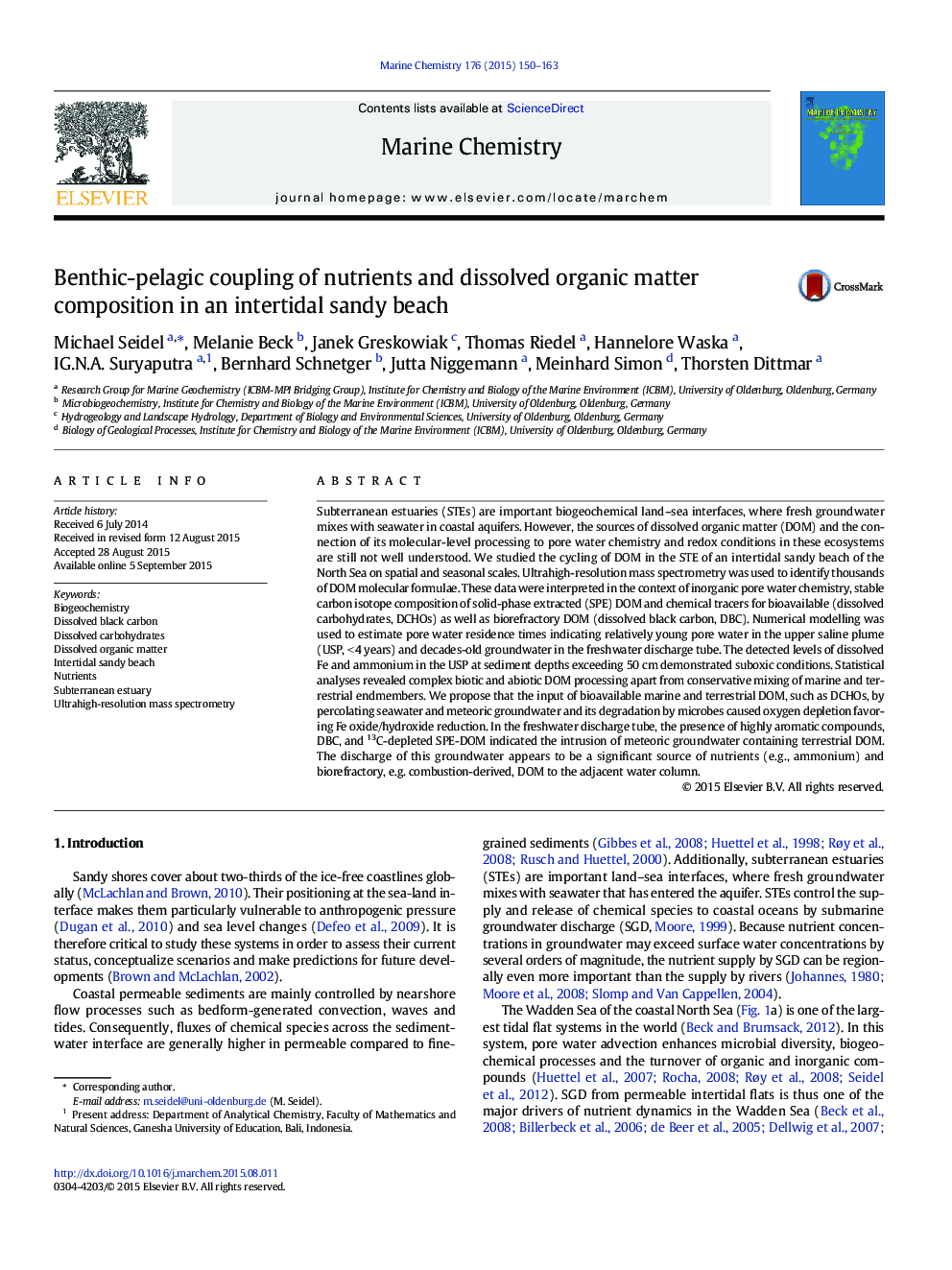| کد مقاله | کد نشریه | سال انتشار | مقاله انگلیسی | نسخه تمام متن |
|---|---|---|---|---|
| 7699260 | 1496659 | 2015 | 14 صفحه PDF | دانلود رایگان |
عنوان انگلیسی مقاله ISI
Benthic-pelagic coupling of nutrients and dissolved organic matter composition in an intertidal sandy beach
ترجمه فارسی عنوان
ترکیب بنفش-پلاژیک مواد مغذی و ترکیب محلول آلی در یک ساحل شنی بین دو طرف
دانلود مقاله + سفارش ترجمه
دانلود مقاله ISI انگلیسی
رایگان برای ایرانیان
کلمات کلیدی
موضوعات مرتبط
مهندسی و علوم پایه
شیمی
شیمی (عمومی)
چکیده انگلیسی
Subterranean estuaries (STEs) are important biogeochemical land-sea interfaces, where fresh groundwater mixes with seawater in coastal aquifers. However, the sources of dissolved organic matter (DOM) and the connection of its molecular-level processing to pore water chemistry and redox conditions in these ecosystems are still not well understood. We studied the cycling of DOM in the STE of an intertidal sandy beach of the North Sea on spatial and seasonal scales. Ultrahigh-resolution mass spectrometry was used to identify thousands of DOM molecular formulae. These data were interpreted in the context of inorganic pore water chemistry, stable carbon isotope composition of solid-phase extracted (SPE) DOM and chemical tracers for bioavailable (dissolved carbohydrates, DCHOs) as well as biorefractory DOM (dissolved black carbon, DBC). Numerical modelling was used to estimate pore water residence times indicating relatively young pore water in the upper saline plume (USP, <Â 4 years) and decades-old groundwater in the freshwater discharge tube. The detected levels of dissolved Fe and ammonium in the USP at sediment depths exceeding 50Â cm demonstrated suboxic conditions. Statistical analyses revealed complex biotic and abiotic DOM processing apart from conservative mixing of marine and terrestrial endmembers. We propose that the input of bioavailable marine and terrestrial DOM, such as DCHOs, by percolating seawater and meteoric groundwater and its degradation by microbes caused oxygen depletion favoring Fe oxide/hydroxide reduction. In the freshwater discharge tube, the presence of highly aromatic compounds, DBC, and 13C-depleted SPE-DOM indicated the intrusion of meteoric groundwater containing terrestrial DOM. The discharge of this groundwater appears to be a significant source of nutrients (e.g., ammonium) and biorefractory, e.g. combustion-derived, DOM to the adjacent water column.
ناشر
Database: Elsevier - ScienceDirect (ساینس دایرکت)
Journal: Marine Chemistry - Volume 176, 20 November 2015, Pages 150-163
Journal: Marine Chemistry - Volume 176, 20 November 2015, Pages 150-163
نویسندگان
Michael Seidel, Melanie Beck, Janek Greskowiak, Thomas Riedel, Hannelore Waska, IG.N.A. Suryaputra, Bernhard Schnetger, Jutta Niggemann, Meinhard Simon, Thorsten Dittmar,
